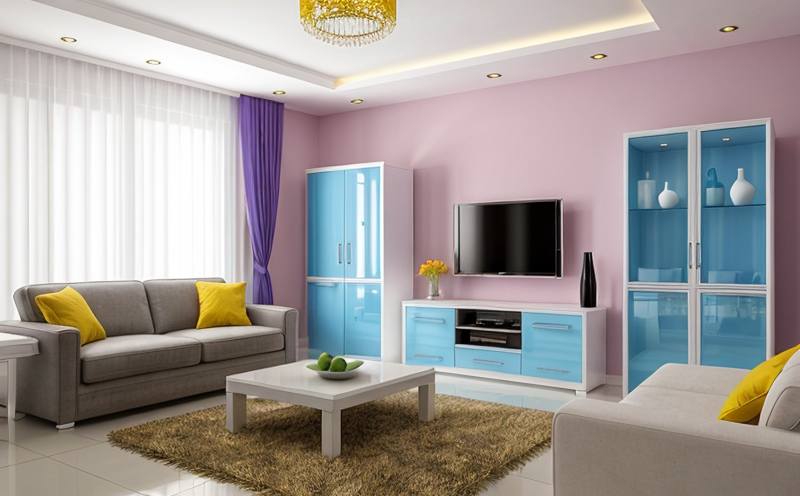BS EN ISO 16000 VOC Emission Testing of Decorative Plastic Materials
The BS EN ISO 16000 series provides a set of internationally recognized standards for the measurement and control of volatile organic compounds (VOCs) in indoor environments. VOC emissions are a significant concern in home decoration plastics due to their potential impact on human health and environmental well-being. This testing ensures that products meet stringent emission limits, thereby contributing to healthier living spaces.
Decorative plastic materials often incorporate various additives such as pigments, flame retardants, stabilizers, and other functional components. These additives can release VOCs during the manufacturing process or over time once installed in homes. By conducting BS EN ISO 16000 tests, manufacturers ensure that their products do not exceed acceptable emission levels set by international standards.
The test procedure outlined in BS EN ISO 16000 involves placing the decorative plastic material inside a climate chamber under controlled conditions. The chamber simulates real-world environmental factors such as temperature and humidity. Over a specified period, the volatile organic compounds emitted from the specimen are collected using an adsorbent tube or other suitable means. After collection, these samples undergo quantitative analysis to determine the total VOC content.
Accurate measurement of VOC emissions is crucial for several reasons:
Firstly, it helps in meeting regulatory requirements imposed by governments and industry bodies. Secondly, it enhances consumer trust by ensuring product safety. Lastly, it supports sustainable practices that are beneficial for both the environment and public health.
| Test Parameters | Specimen Preparation | Instrumentation Used | Reporting Criteria |
|---|---|---|---|
| Temperature, Humidity Conditions | Cutting Specimens to Standard Sizes | Climate Chambers, Adsorbent Tubes | Total VOC Content Limits |
| Emission Time Duration | Surface Area Calculation | Analytical Instruments for Quantification | Pass/Fail Criteria Based on Standards |
The testing process is meticulous and involves precise calibration of equipment to ensure accurate results. Proper specimen preparation, including cutting them into standard sizes, is essential to obtain consistent readings.
In conclusion, BS EN ISO 16000 VOC Emission Testing is vital for manufacturers producing decorative plastic materials. It ensures compliance with international standards, promotes safer products, and supports sustainable manufacturing practices.
Why It Matters
The importance of VOC emission testing cannot be overstated in the context of home decoration plastics. Indoor air quality is a critical factor in maintaining healthy living environments. Excessive levels of VOCs can lead to various health issues ranging from headaches and nausea to more severe conditions like asthma and cancer.
Manufacturers must adhere to stringent regulations set by organizations such as the European Commission, which aims to protect citizens' health by limiting harmful emissions. By conducting rigorous testing according to BS EN ISO 16000 standards, companies demonstrate their commitment to quality and safety. This not only enhances brand reputation but also fosters customer confidence.
Furthermore, sustainable practices play a key role in today's market. Consumers are increasingly demanding eco-friendly products that contribute positively to the environment. Meeting VOC emission limits aligns with these expectations, making it easier for businesses to attract environmentally conscious customers.
The health benefits of reducing VOC emissions extend beyond individual products; they also impact broader societal well-being. Cleaner indoor air contributes significantly towards improving public health outcomes globally.
Industry Applications
| Application Area | Description |
|---|---|
| Furnishing & Interior Design | Incorporation of decorative plastic materials in furniture, carpets, and wall coverings. |
| Cabinet Manufacturing | Production of cabinets for kitchens, bathrooms, and home offices using decorative plastics. |
| Flooring Solutions | Utilization of decorative plastic flooring in residential and commercial settings. |
| Home Appliances | Incorporation into components like handles, control panels, and casings. |
These applications highlight the versatility and widespread use of decorative plastics across various sectors within the home decoration industry. Ensuring these materials meet VOC emission standards is crucial for maintaining high-quality products that contribute positively to indoor air quality.
Use Cases and Application Examples
| Case Study | Description |
|---|---|
| Residential Furniture Manufacturer | A furniture manufacturer uses decorative plastic materials for cushion covers. By adhering to BS EN ISO 16000 testing, they ensure that their products emit negligible VOCs, enhancing the comfort and safety of users. |
| Cabinet Factory | Manufacturers producing kitchen cabinets incorporate various types of decorative plastics into their designs. Rigorous VOC emission testing ensures these materials comply with regulatory requirements while maintaining aesthetic appeal. |
| Commercial Office Decorator | An office decorator selects decorative plastic wall panels for a corporate interior renovation project. Testing according to BS EN ISO 16000 guarantees that the chosen material will not compromise air quality within the workspace. |
| Home Appliance Producer | A producer of home appliances ensures all decorative plastics used in their products meet VOC emission limits set by international standards. This commitment to quality enhances consumer trust and satisfaction. |
These examples demonstrate how different stakeholders in the home decoration industry benefit from adhering to BS EN ISO 16000 VOC Emission Testing procedures. By doing so, they contribute significantly towards creating safer, more sustainable living spaces.





